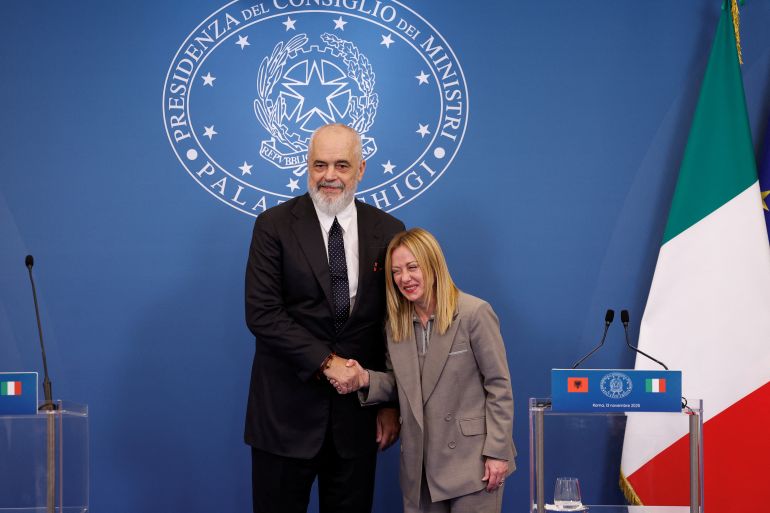Italy’s PM Meloni determined to continue sending migrants to Albania
Giorgia Meloni’s plan to use detention centres in Albania has faced numerous legal challenges and human rights criticism.

By Abby Rogers, AFP and Reuters
Published On 13 Nov 202513 Nov 2025
Save
Italian Prime Minister Giorgia Meloni has doubled down on her government’s plans to send migrants and asylum seekers to detention centres in Albania, despite opposition from Italian judges and the European Union’s top court.
Speaking at a summit in Rome alongside Albanian Prime Minister Edi Rama, Meloni said her right-wing government was “determined” to forge ahead with its scheme of sending migrants and asylum seekers outside the EU while their claims are processed.
Recommended Stories
list of 3 itemsend of list
In a deal approved by the Albanian Parliament in February 2024, the Eastern European country agreed to hold up to 3,000 migrants and asylum seekers at any one time in two Italian-run processing centres located near the port of Shengjin.
Under the plan at the time, the migrants and asylum seekers would be held for periods of about a month. It was expected that up to 36,000 people a year could be sent from Italian custody to Albania over an initial period of five years.
According to the deal, people would be screened initially on board the ships that rescue them before being sent to Albania for further screening.
The centres were meant to be operated under Italian law with Italian security and staff. Italian judges would hear the immigration cases via video from Rome.
The agreement was denounced by rights groups, with the International Rescue Committee describing it as “dehumanising“. Amnesty International condemned it as “illegal and unworkable”.
As of August 1, Italy saw 36,557 migrant arrivals in 2025. That number is slightly up from the same period of 2024, but far below the 89,165 recorded over the same time span in 2023.
Following parliamentary approval, Italy sent its first ship carrying asylum seekers and migrants — 10 men from Bangladesh and six from Egypt — to Albania’s Shengjin port in October 2024.
Advertisement
But very quickly, four of the men were identified as “vulnerable” and sent back to Italy. Within two days, the remaining 12 men were sent back too, after an Italian court ruled against their detention.
Italy then sent ships of asylum seekers to Albania in January and April 2025, despite court challenges.
Meloni’s plan has been mired in legal challenges from the start. Italian judges have repeatedly rejected deportations from the centres, ruling that the asylum seekers’ countries of origin were not safe enough for them to be sent back.
The cases were referred to the European Court of Justice (ECJ), which had earlier established that asylum applicants could not undergo a fast-track procedure for repatriation if their home countries were not deemed safe.
The ECJ ultimately backed Italian judges in a ruling in August, questioning Meloni’s list of “safe countries”.
Meloni’s government had issued a decree establishing a list of 19 supposedly safe countries of origin, which includes Egypt and Bangladesh. However, the EU has not classified either as a safe country of origin.
The ECJ said Italy is free to decide which countries are “safe” but warned that such a designation should meet strict legal standards and allow applicants and courts to access and challenge the supporting evidence.
The ECJ also said a country might not be classified “safe” if it does not offer adequate protection to its entire population, agreeing with Italian judges who had raised the same issue last year.
The detention facilities in Albania have been empty for months due to the judicial obstacles. Earlier this year, a report found that their construction cost was seven times more than that of an equivalent centre in Italy.
